From Pantone’s Colour of the Year to the Ugliest Colour in the World
From Pantone’s Colour of the Year to the Ugliest Colour in the World
Every December, designers, trend forecasters and brand strategists hold their collective breath waiting for one announcement: the Pantone Colour of the Year.
It’s a tradition that shapes fashion collections, marketing palettes and Instagram feeds for months. The colour isn’t just a shade, it’s a statement about mood, emotion, and culture.
Pantone calls it “a snapshot of what we see taking place in our global culture.”
But while we celebrate colour as art and emotion, there’s another, far darker side to colour psychology, one that’s used not to attract, but to repel.
Colour That Inspires — and Colour That Discourages
Each year, Pantone tells us what’s in.
From Viva Magenta to Classic Blue and Peach Fuzz, these shades are chosen for how they make us feel: hopeful, energetic, calm, connected.
But what about colours chosen specifically to make us feel the opposite, disgust, discomfort, even shame?
That’s where the infamous “world’s ugliest colour” comes in.
Meet Pantone 448C: The Colour Designed to Make You Quit
Back in 2012, the Australian government commissioned a study to find a colour that would make cigarette packaging as unattractive as possible. After testing dozens of shades with focus groups, they found a clear winner, or rather, loser.
Pantone 448C, a murky brown-green-grey, was officially declared the world’s ugliest colour.
Psychologists described it as “dirty”, “deathly”, and “tar-like”. Focus groups associated it with decay, filth, and sickness.
It was so repulsive that it became the standard colour for plain cigarette packaging, deliberately chosen to make smoking feel less glamorous and more grim.
And it worked.
Australia saw a noticeable decline in smoking rates after the packaging change, and several countries, including the UK, France and New Zealand, followed suit.
A single colour had changed behaviour.
The Psychology Behind the Palette
We often think of colour as aesthetic — a creative choice. But colour is psychological before it’s visual. It speaks to our instincts.
- Warm colours (reds, oranges) evoke passion, energy and appetite.
- Cool tones (blues, greens) feel calm, clean, trustworthy.
- Muted tones — especially browns and greys — can feel lifeless or institutional.
That’s why Pantone 448C was so effective: it stripped away the allure. It took something once designed to feel sleek and desirable, and rebranded it as something repulsive.
It’s a clever inversion of what brands normally do — colour not to attract, but to discourage.
Colour as Communication
The contrast between Pantone’s joyful Colour of the Year campaigns and the government’s anti-smoking palette highlights something fascinating: colour can carry meaning without words.
Pantone uses colour to express emotion, to unify global design under shared optimism.
Governments use colour to influence public behaviour and perception.
Both rely on the same truth, colour speaks directly to the subconscious.
Designers already know this intuitively: a good colour choice can sell a product, shift a mood, or define a brand. But the “ugliest colour in the world” reminds us that design can also serve a social purpose, that sometimes, beauty isn’t the goal.
Beauty, Behaviour, and Branding
There’s a poetic irony in how colour theory bridges design and psychology.
While brands chase Pantone trends to appear relevant or aspirational, governments use the very same science to save lives.
It shows that colour isn’t neutral; it carries cultural, emotional, and even ethical weight.
What’s “beautiful” in one context might be “disgusting” in another, depending entirely on what we’re trying to achieve.
Maybe that’s the real lesson behind Pantone’s yearly ritual: it’s not just about the colour we celebrate, but how we understand the power of colour itself.
From inspiring art to discouraging addiction, colour design sits quietly at the crossroads of creativity and psychology — shaping how we feel, and sometimes, how we behave.

When Artists Couldn’t Draw Horses Running
When Artists Couldn’t Draw Horses Running
When Artists Couldn’t Draw Horses Running
Before photography galloped into the picture, even the greatest artists were getting one thing consistently and hilariously wrong:
How horses run.
For centuries, painters and sculptors depicted galloping horses with their legs stretched out like leaping greyhounds, front legs forward, back legs extended behind, suspended in mid-air, frozen in a majestic, yet physically impossible stride.
It looked powerful. It looked elegant. It looked completely wrong.
Before the Lens, There Was Guesswork
Before cameras, artists had only one tool for capturing motion: observation.
But the human eye and brain can’t process movement that fast. Horses gallop at such speed that, without photographic reference, it’s impossible to see the exact positioning of their legs.
So, for centuries, artists simply guessed.
They used logic and aesthetics instead of science. If a horse runs fast, surely its legs must stretch far apart, right?
It was a natural assumption, until technology proved otherwise.
Enter Eadweard Muybridge: The Man Who Froze Motion
In the 1870s, a man named Eadweard Muybridge, a British photographer working in the United States, was hired to solve a hotly debated question:
When a horse gallops, are all four hooves ever off the ground at once?
To find out, Muybridge set up a line of cameras triggered by tripwires along a racetrack.
The resulting series of photographs, captured in rapid succession, revealed something no one had ever seen before.
Yes, all four hooves do leave the ground, but not when the legs are stretched out.
Instead, it happens when the legs are tucked under the body, mid-stride, the complete opposite of what centuries of art had shown.
It was a revelation.
And it changed the way people understood movement forever.
When Art Meets Evidence
Muybridge’s photos didn’t just correct an artistic mistake, they shifted how humans thought about seeing, truth, and representation.
For the first time, artists and scientists had proof that the eye could deceive.
Movement, once fluid and mysterious, could now be dissected frame by frame.
Painters, sculptors and animators began to study these sequences, leading to more realistic depictions of not just horses, but all living motion.
You can see Muybridge’s influence ripple through everything from classical painting to early animation to the biomechanics used in CGI today.
The Poetry of Imperfection
And yet, there’s something charming about those pre-photography depictions.
They remind us that art isn’t just about accuracy, it’s about interpretation.
When artists painted horses before photography, they weren’t trying to lie. They were capturing the feeling of speed, power, and grace, the essence of motion, rather than its exact mechanics.
In a way, those elongated, impossible strides were more about emotion than anatomy.
They show how art has always been a collaboration between imagination and perception, a dialogue between what we think we see and what we feel to be true.
Technology and Truth
The horse paintings of the pre-photography era tell a larger story about technology’s role in art.
Every new tool, from the camera to AI, reshapes how we define creativity.
When photography arrived, artists didn’t become obsolete. They adapted. Impressionists like Degas and Monet began using photographic reference and motion studies to create new forms of realism — emotional, fleeting, human.
In the same way, today’s artists are learning to coexist with digital tools and AI, finding new ways to express timeless questions:
What’s real? What’s beautiful? What’s worth capturing?
A Gallop Through Time
So next time you see an old painting of a horse sprinting with legs stretched out like a cartoon, smile. It’s not a mistake. It’s a snapshot of a world before cameras, before slow motion, before science could catch up with imagination.
It’s proof that art has always been about more than getting it right.
It’s about trying to see, and sometimes, the trying itself is what makes it beautiful.
Because long before photography showed us the truth, art taught us to look for it.

Xania Monet: The AI R&B Artist Causing a Real-World Backlash
Xania Monet
The AI R&B Artist Causing a Real-World Backlash
The music industry has officially entered a new era — one where record deals aren’t just being signed by singers, but by software.
This month, the internet has been buzzing over Xania Monet, an AI-generated R&B artist who reportedly signed a multi-million-dollar record deal with Hallwood Media after climbing the Billboard R&B Airplay charts.
She’s got a voice, a catalogue, a label — everything you’d expect from a real artist. Except she isn’t one.
Xania Monet doesn’t exist. Not in the way we understand existence.
And not everyone’s applauding.
A New Kind of Star
Xania Monet was created by Telisha “Nikki” Jones, a poet and lyricist from Mississippi, who used the AI music platform Suno to bring her creative vision to life.
Monet’s songs are sultry, soulful, and algorithmically perfect — her tone silky, her rhythm precise, her imperfections… nonexistent.
On paper, it sounds revolutionary: an artist who can sing forever, never gets tired, and doesn’t need a recording booth, tour budget, or vocal warm-up.
But to many musicians, it’s not innovation. It’s an invasion.
The Backlash Begins
The announcement of Monet’s record deal was met with immediate backlash across social media and within the music community.
Kehlani, the acclaimed R&B singer-songwriter, was one of the first to speak out.
In a viral post, she said:
“There’s an AI R&B artist who just signed a multi-million dollar deal… and the person is doing none of the work. Nothing and no one on Earth will ever be able to justify that to me.”
It’s a sentiment shared by many: that celebrating a machine-made artist in a genre built on emotion, storytelling, and lived experience feels like a betrayal of everything R&B stands for.
Because R&B isn’t just about sound — it’s about soul.
When the Machine Sings the Blues
There’s something almost poetic about an AI entering the world of R&B — a genre rooted in human vulnerability, pain, and love.
The irony isn’t lost on anyone.
How can a non-human entity sing about heartbreak, desire, or loss when it can’t feel any of those things?
For many artists, the rise of AI performers threatens to reduce art to data — stripping away the humanity that makes music meaningful.
Even if Xania Monet’s songs sound beautiful, they’re missing something invisible yet vital: a heartbeat.
The Industry’s AI Obsession
Record labels see AI differently.
They see efficiency. Consistency. Control.
An AI artist doesn’t demand royalties, take holidays, or go off-script in interviews.
It can be replicated endlessly, customised for audiences, and marketed across multiple languages.
It’s a label’s dream — and a human artist’s nightmare.
But there’s another layer too: AI models like Monet are trained using existing music. That means fragments of real artists’ vocals, melodies, and styles may have been used to create her sound — without their consent.
For many, that’s not innovation. It’s exploitation.
A Question of Authenticity
Every generation of musicians faces disruption — from autotune to streaming, technology has always redefined what’s possible.
But AI feels different because it doesn’t just enhance human creativity — it replaces it.
When an algorithm can now perform, produce, and promote itself, we’re forced to ask:
Where does human artistry fit in?
And more importantly:
Will audiences actually care who — or what — made the music, as long as it sounds good?
The Heart of the Matter
R&B is a genre that’s always been about emotion and truth — from Aretha Franklin to SZA. It’s the sound of real experience.
That’s why Kehlani’s response hit a nerve.
Her frustration isn’t just about job security — it’s about meaning.
Art isn’t just about output; it’s about connection.
AI can write, sing, and simulate emotion — but it can’t feel it.
And maybe that’s the point where audiences will draw the line.
The Future: Collaboration or Competition?
Xania Monet’s rise doesn’t have to spell the end of human artistry — but it should serve as a wake-up call.
If used responsibly, AI could be a collaborator — helping artists experiment, compose, or visualise ideas in new ways.
But when AI becomes the artist, it raises a deeper ethical question: what does it mean to create, when creation no longer requires being alive?
Whether you love or hate her, Xania Monet is here to stay — a mirror held up to an industry that’s racing ahead faster than it can define its own values.
The real challenge now isn’t whether AI can make music.
It’s whether music made by AI can still move us.
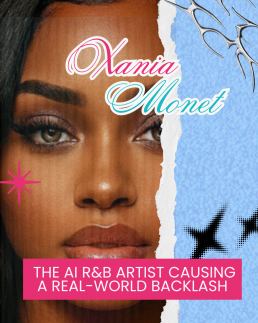
Castell Coch - £25.00
Castell Coch Illustration
£25.00
Castell Coch is a digitally hand-drawn illustration from the Places Series, capturing the fairytale charm of this 19th-century Gothic Revival castle nestled in the lush woodlands of Tongwynlais, South Wales. The artwork highlights the castle’s striking turrets and pointed roofs as they emerge from dense green forest, evoking both mystery and enchantment. With bold colour blocking and a modern poster art style, the piece celebrates one of Wales’ most picturesque landmarks.
Style
Digital hand-drawn illustration with poster art influences and bold, simplified forms
Subject
Castell Coch, a Gothic Revival castle, framed by dense woodland in South Wales
Background
Deep green layers of forest, creating contrast with the castle’s pale stone and rooftops
Series
Places | Welsh Places
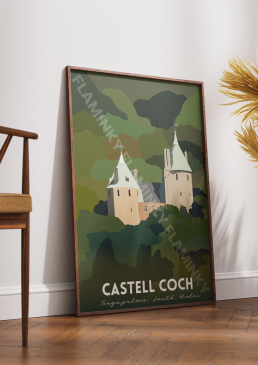

Harlech Castle - £25.00
Harlech Castle Illustration
£25.00
Harlech Castle is a digitally hand-drawn illustration from the Places Series, portraying the dramatic beauty of this UNESCO World Heritage Site in Gwynedd, North Wales. The artwork highlights the castle’s commanding stone walls perched atop a rugged hill, with sweeping views of the countryside and the sea beyond. Using bold colour blocking and a clean poster art style, the piece captures both the strength of medieval architecture and the natural beauty of its coastal setting.
Style
Digital hand-drawn illustration with poster art and bold color blocking
Subject
Harlech Castle in Gwynedd, North Wales, emphasizing its imposing fortress structure and elevated position
Background
Expansive countryside and coastal horizon under a cloud-dotted sky
Series
Places | Welsh Places


Conwy Castle - £25.00
Conwy Castle Illustration
£25.00
Conwy Castle is a digitally hand-drawn illustration from the Places Series, celebrating one of North Wales’ most iconic medieval landmarks. The artwork captures the castle’s towering stone walls and battlements rising above the river, with its reflection shimmering in the water below. Rendered in bold colour blocks and clean forms, the piece combines historical grandeur with a contemporary poster art style, making it both nostalgic and modern.
Style
Digital hand-drawn illustration with poster art and bold color blocking
Subject
Conwy Castle in North Wales, highlighting its medieval architecture and dramatic riverside setting
Background
Soft blue sky and reflective water that enhance the castle’s strength and presence
Series
Places | Welsh Places
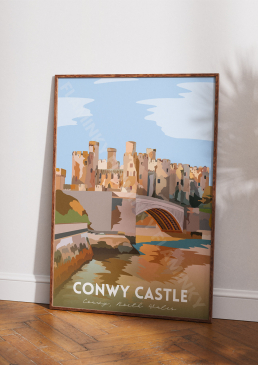
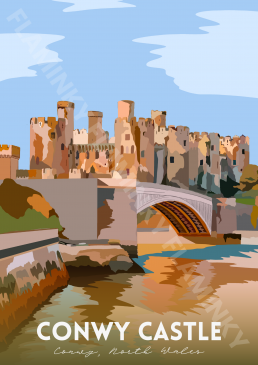
Portmeirion - £25.00
Portmeirion Illustration
£25.00
Portmeirion is a digitally hand-drawn illustration from the Places Series, celebrating the whimsical charm of this iconic village in Gwynedd, North Wales. The artwork captures the eclectic architecture, bold colours, and Mediterranean-inspired details that make Portmeirion so unique. With its bright blue skies, sunlit domes, and vibrant facades, the piece evokes the joy of travel, culture, and discovery, offering a modern take on classic travel poster design.
Style
Digital hand-drawn illustration with bold color blocking and poster art influences
Subject
The distinctive architecture of Portmeirion, featuring domes, facades, and dramatic rocky landscape
Background
Clear blue sky and layered structures highlighting the village’s playful elegance
Series
Places | Welsh Places


Afro - £25.00
Afro
£25.00
Afro is a digitally hand-drawn portrait from the Pop Nostalgia Series, merging retro culture with bold surrealism. The artwork features a striking figure with a voluminous afro, oversized hoop earrings, and dripping neon-pink glasses that melt into the composition. Set against a vibrant turquoise halftone background, the piece radiates confidence, power, and playful rebellion while reimagining 70s-inspired style through a modern pop art lens.
Style
Digital hand-drawn illustration with pop art and surrealist influences
Subject
A stylized portrait featuring a bold afro, large hoop earrings, and melting neon-pink glasses
Background
Bright turquoise halftone backdrop, amplifying the retro pop aesthetic
Series
Pop | Nostalgia
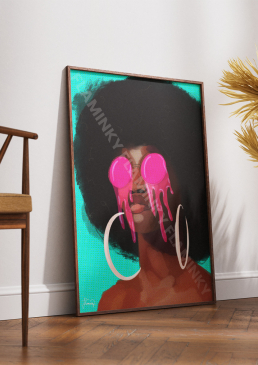

Flower Cola - £25.00
Flower Cola
£25.00
Change the color to match your brand or vision, add your logo, choose the perfect layout, modify menu settings, add animations, add shape dividers, increase engagement with call to action and more.
Style
Digital hand-drawn illustration with pop art and contemporary influences
Subject
A crushed soda can used as a vase, filled with vivid yellow flowers
Background
Bright turquoise with halftone texture, adding energy and contrast
Series
Plants


Male Back Torso - £25.00
Male Back Torso
£25.00
Male Back Torso is a digitally hand-drawn anatomical study that celebrates the strength and structure of the human form. Rendered with expressive pencil strokes and subtle tonal shading, the artwork highlights the muscular definition and natural contours of the male back. The textured sketch-like finish gives the piece a timeless, classical quality while retaining a modern digital edge.
Style
Digital hand-drawn anatomical study with sketch and shading techniques
Subject
Male torso from the back, emphasizing musculature and form
Background
Minimal with soft textured strokes that frame the figure
Series
Traditional


